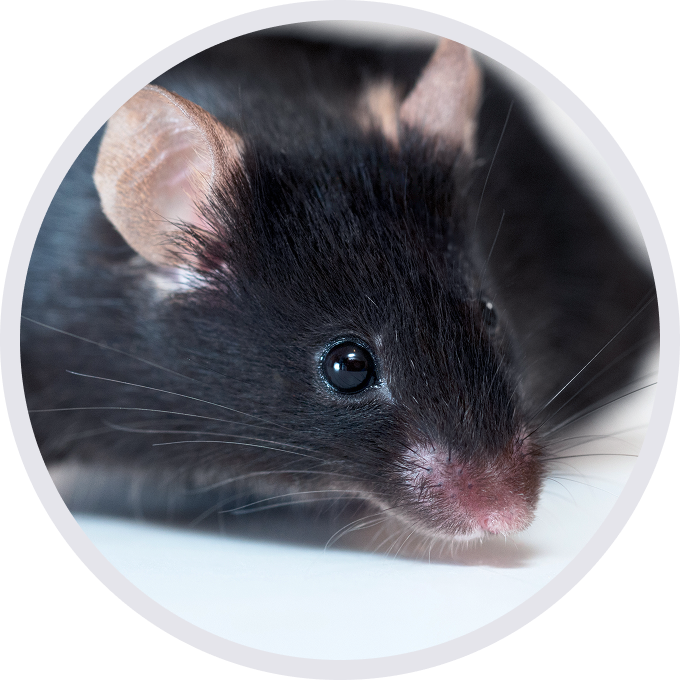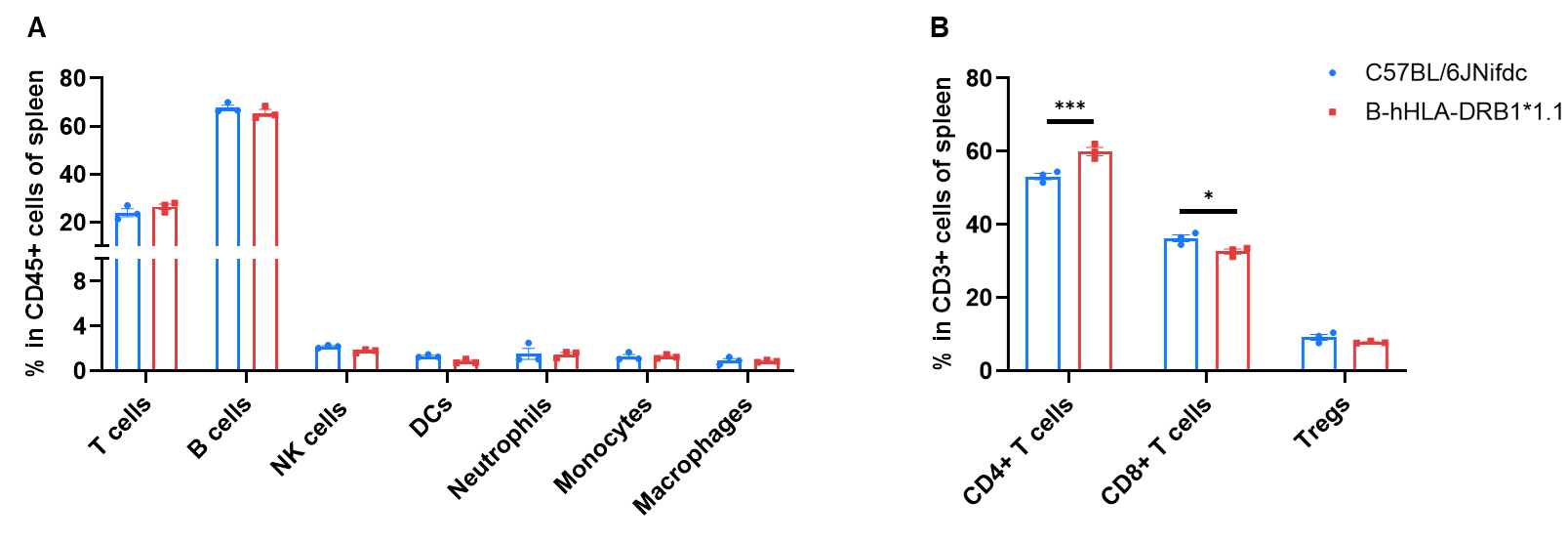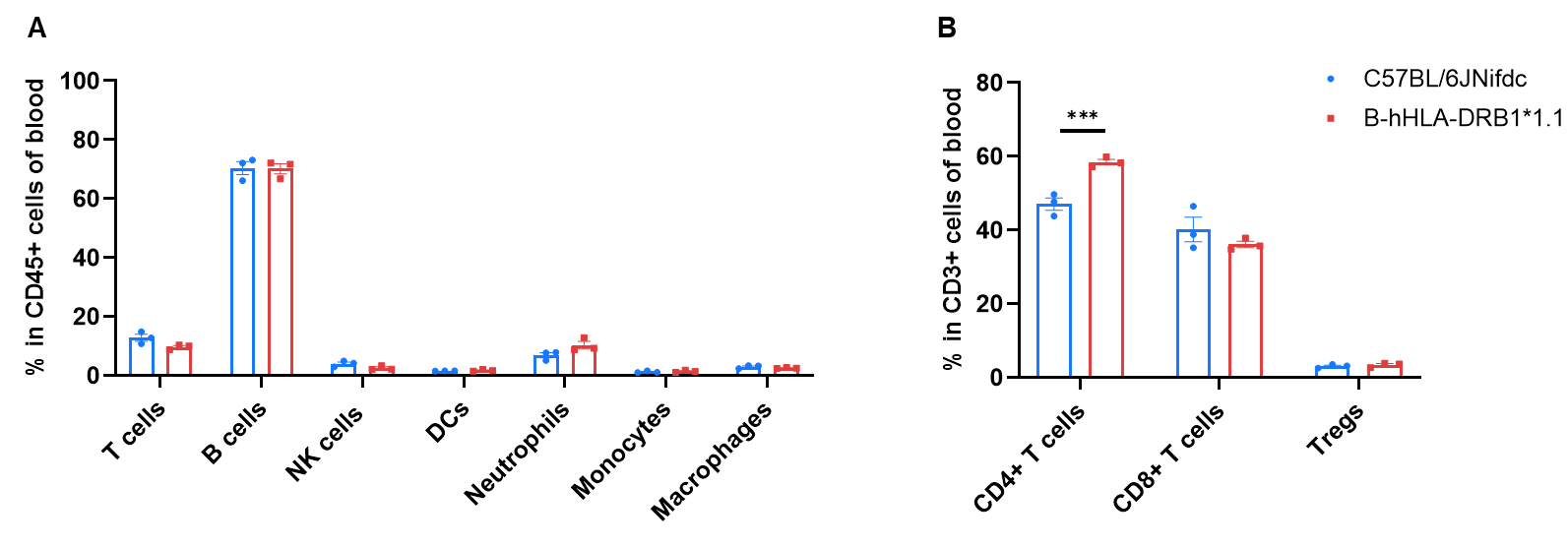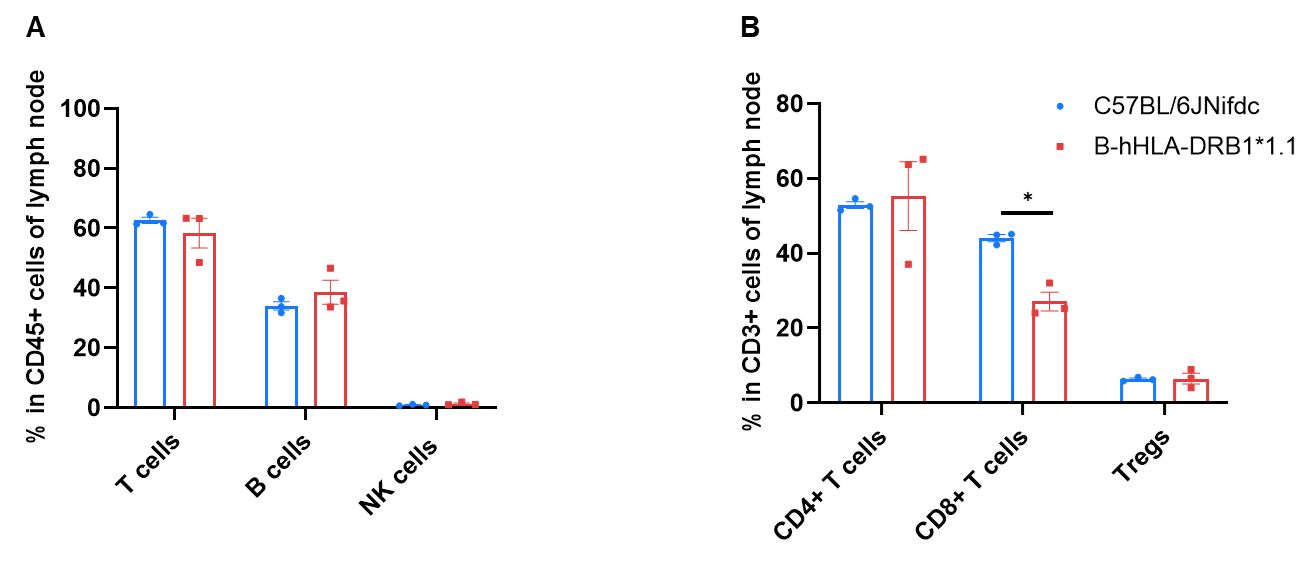
C57BL/6-H2-Eatm1(HLA-DRA1*1.1-I-Ea)Bcgen H2-Eb1tm1(HLA-DRB1*1.1-I-Eb1)Bcgen H2-Atm1Bcgen H2-Eb2tm1Bcgen/Bcgen • 112898

Gene targeting strategy for B-hHLA-DRB1*1.1 mice. The exon 2 of mouse I-Ea gene that encodes the extracellular domain of I-Ea was replaced by human HLA-DRA encoding the α1 domain in B-hHLA-DRB1*1.1 mice. The exon 2 of mouse I-Eb1 gene that encodes the extracellular domain of I-Eb1 was replaced by human HLA-DRB encoding the β1 domain in B-hHLA-DRB1*1.1 mice. The mouse I-Aa, I-Ab1 and I-Eb2 were knocked out in B-hHLA-DRB1*1.1 mice.

Strain specific HLA-DRB1 expression analysis in wild-type C57BL/6JNifdc mice and homozygous B-hHLA-DRB1*1.1 mice by flow cytometry. Splenocytes were collected from wild-type C57BL/6JNifdc (+/+) and homozygous humanized B-hHLA-DRB1*1.1 mice (H/H), respectively, and analyzed by flow cytometry with species-specific anti-mouse I-A/I-E antibody (Biolegend, 107607), and species-specific anti-human HLA-DR antibody (Biolegend, 307610). Human HLA-DRB1 was exclusively detectable in homozygous B-hHLA-DRB1*1.1 mice, but not in wild-type C57BL/6JNifdc mice.

Strain specific HLA-DRB1 expression analysis in wild-type C57BL/6JNifdc mice and homozygous B-hHLA-DRB1*1.1 mice by flow cytometry. Blood cells were collected from wild-type C57BL/6JNifdc mice (+/+) and homozygous humanized B-hHLA-DRB1*1.1 mice (H/H), respectively, and analyzed by flow cytometry with species-specific anti-mouse I-A/I-E antibody (Biolegend, 107607), and species-specific anti-human HLA-DR antibody (Biolegend, 307610). Human HLA-DRB1 was exclusively detectable in homozygous B-hHLA-DRB1*1.1 mice, but not in wild-type C57BL/6JNifdc mice.

Strain specific HLA-DRB1 expression analysis in wild-type C57BL/6JNifdc mice and homozygous B-hHLA-DRB1*1.1 mice by flow cytometry. Bone marrow cells were collected from wild-type C57BL/6JNifdc mice (+/+) and homozygous humanized B-hHLA-DRB1*1.1 mice (H/H), respectively, and analyzed by flow cytometry with species-specific anti-mouse I-A/I-E antibody (Biolegend, 107607), and species-specific anti-human HLA-DR antibody (Biolegend, 307610). Human HLA-DRB1 was exclusively detectable in homozygous B-hHLA-DRB1*1.1 mice, but not in wild-type C57BL/6JNifdc mice.

Frequency of leukocyte subpopulations in spleen by flow cytometry. Splenocytes were isolated from wild-type C57BL/6JNifdc mice (female, n=3, 8-week-old) and homozygous B-hHLA-DRB1*1.1 mice (female, n=3, 8-week-old). A. Flow cytometry analysis of the splenocytes was performed to assess the frequency of leukocyte subpopulations. B. Frequency of T cell subpopulations. Frequencies of T cells, B cells, NK cells, dendritic cells, neutrophils, monocytes, macrophages, and Tregs in B-hHLA-DRB1*1.1 mice were similar to those in C57BL/6JNifdc mice. Compared with C57BL/6JNifdc mice, the frequency of CD4+ T cells in B-hHLA-DRB1*1.1 mice was increased than C57BL/6JNifdc mice, while the frequency of CD8+ T cells in B-hHLA-DRB1*1.1 mice was decreased than C57BL/6JNifdc mice in the spleen. Values are expressed as mean ± SEM. Significance was determined by two-way ANOVA test. *P < 0.05, **P < 0.01, ***P < 0.001.

Frequency of leukocyte subpopulations in blood by flow cytometry. Blood cells were isolated from wild-type C57BL/6JNifdc mice (female, n=3, 8-week-old) and homozygous B-hHLA-DRB1*1.1 mice (female, n=3, 8-week-old). A. Flow cytometry analysis of the blood leukocytes was performed to assess the frequency of leukocyte subpopulations. B. Frequency of T cell subpopulations. Frequencies of T cells, B cells, NK cells, dendritic cells, neutrophils, monocytes, macrophages, and Tregs in B-hHLA-DRB1*1.1 mice were similar to those in C57BL/6JNifdc mice. Compared with C57BL/6JNifdc mice, the frequency of CD4+ T cells in B-hHLA-DRB1*1.1 mice was increased than C57BL/6JNifdc mice. The frequency of CD8+ T cells in B-hHLA-DRB1*1.1 mice was decreased than C57BL/6JNifdc mice, but there was no statistical difference in the blood. Values are expressed as mean ± SEM. Significance was determined by two-way ANOVA test. *P < 0.05, **P < 0.01, ***P < 0.001.

Frequency of leukocyte subpopulations in lymph node by flow cytometry. Lymph node cells were isolated from wild-type C57BL/6JNifdc mice (female, n=3, 8-week-old) and homozygous B-hHLA-DRB1*1.1 mice (female, n=3, 8-week-old). A. Flow cytometry analysis of the leukocytes was performed to assess the frequency of leukocyte subpopulations. B. Frequency of T cell subpopulations. Frequencies of T cells, B cells, NK cells, dendritic cells, neutrophils, monocytes, macrophages, and Tregs in B-hHLA-DRB1*1.1 mice were similar to those in C57BL/6JNifdc mice. Compared with C57BL/6JNifdc mice, the frequency of CD4+ T cells in B-hHLA-DRB1*1.1 mice was increased than C57BL/6JNifdc mice, but there was no statistical difference. The frequency of CD8+ T cells in B-hHLA-DRB1*1.1 mice was decreased than C57BL/6JNifdc mice in the lymph node. Values are expressed as mean ± SEM. Significance was determined by two-way ANOVA test. *P < 0.05, **P < 0.01, ***P < 0.001.